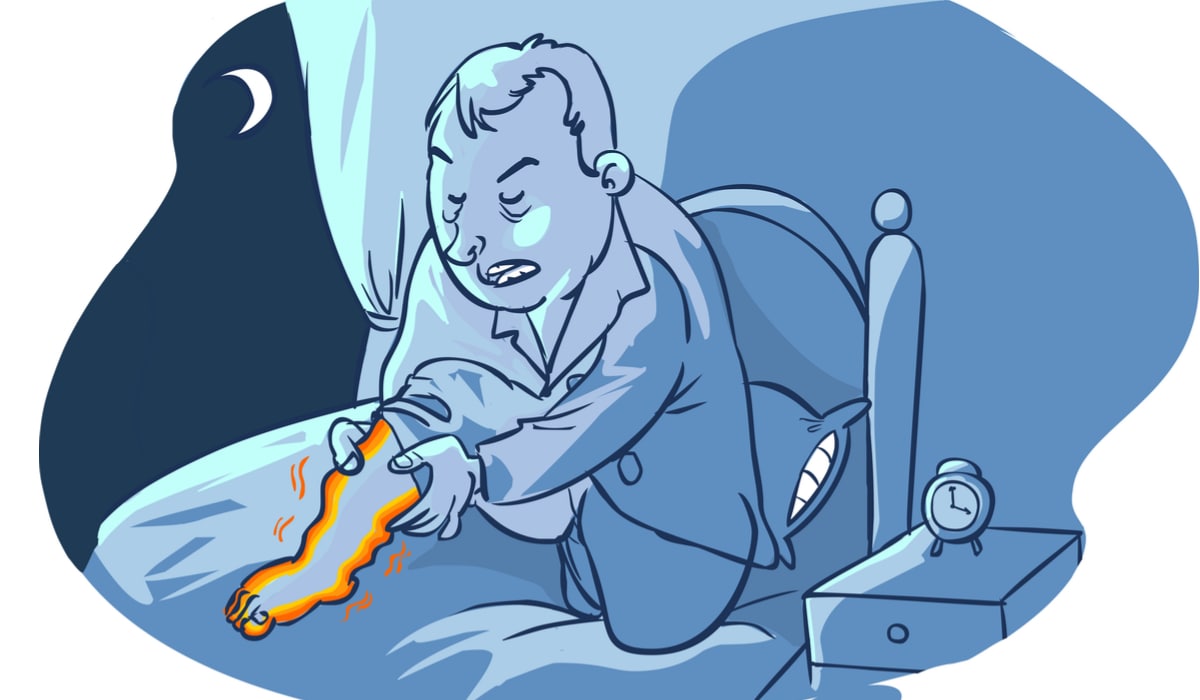
When most people think of sleep disorders, obstructive sleep apnea (OSA) is usually the first to come to mind. The sleep medicine community is learning more and more about how OSA affects individual health and well-being. The majority of our patients at Sleep Resolutions seek out treatment because of OSA symptoms, and many other sleep disorders are underrepresented in sleep medicine discussions.
Restless leg syndrome has crossover symptoms with many other sleep disorders and can be more challenging to diagnose. Restless leg syndrome is the unpleasant and uncontrollable urge or sensation to move your legs, sometimes arms, and other extremities.
What is Restless Leg Syndrome (RLS)
Restless leg syndrome is also knowns as Willis-Ekbom Disease. Restless leg syndrome is the unpleasant and uncontrollable urge or sensation to move your legs, sometimes arms, and other extremities.
Symptoms vary for each person but commonly appear in the late afternoon into the evening hours. Many patients report that their symptoms gradually increase as the evening progress. Those that experience RLS struggle to fall asleep because of the urge to move.
Restless leg syndrome is classified as a sleep disorder, a movement disorder, and a neurological disorder. RLS is a sleep disorder because of sleeping and resting trigger symptoms, a movement disorder because movement relieves symptoms, and a neurological disorder because symptoms have been tracked to originate within the brain itself.
Roughly 7-10% of the population suffers from restless leg syndrome. It occurs in men and women but is more prevalent for women. It can manifest at any age but typically appears in middle-aged and older people.
Symptoms of RLS
Symptoms of restless leg syndrome vary from person to person. RLS can develop at any age, however, it's more common in middle-age and older people. Children experience similar symptoms; unfortunately, it is more difficult to diagnose. Children struggle to communicate their symptoms and often their behaviors are attributed to growing pains.
Symptoms of restless leg syndrome include:
-
Sensations in the legs that begin at times of rest or sleep.
-
The sensations increase in duration, frequency, and discomfort as the evening progresses.
-
Nighttime leg twitching. Periodic Limb Movement of Sleep (PLMS) disorder is another disorder that occurs commonly for those with RLS although PLMS doesn't occur for all RLS patients.
-
Relief with movement.
These symptoms can also impact a patient’s arms, chest, or even the head, however, it rarely occurs in these areas. Patients can experience RLS on only one side of their body or both sides. Patients struggle to describe the sensation.
These sensations are described as creeping, electric, crawling, aching, itching, throbbing, pulling, and occur within the limb versus on the skin.
Other secondary symptoms of RLS include:
-
Daytime sleepiness
-
Difficulties falling or staying asleep
-
Decreased productivity
-
Mood swings
These secondary symptoms are common in many different sleep disorders and are often the reason that most seek out treatment. RLS has a direct and immediate effect on a person’s life, and the longer that symptoms persist, the more severe they are likely to become.
It is possible for patients to go through extended periods where they experience no symptoms at all, remission. Remission periods are more common in the early stages of RLS, and little is known about what causes the break in symptoms.
If patients have other associated medical conditions along with RLS, their symptoms are more likely to be severe and more intense.
Presentation in children
Younger children have a difficult time articulating their symptoms to medical providers and even their parents. The National Institute of Health has estimated that there are one million children that suffer from restless leg syndrome. Their complaints are commonly mistaken for growing pains, attention deficit disorder, or even poor sleep routine/sleep hygiene.
Its difficult for adults to describe the sensations that occur during episodes of RLS, so imagine children that have less ability to express their symptoms
Parents and medical provider should look for the following signs in children:
-
Struggles at bedtime. Again, the symptoms begin at times of rest. It will make falling asleep difficult for children.
-
Their frequent movement to relieve symptoms. If you notice frequent movements that your child is making before they fall asleep, make sure to share how often that is occurring with the child’s medical provider.
-
Daytime drowsiness. Children might be more prone to take naps or have behavioral struggles as a result of being tired. Parents know their children and can tell when they need more sleep. Children may want to sleep more in the morning hours when symptoms are less prevalent, making sleep easier to achieve.
-
Poor academic performance. Just like adults, children that are not getting enough sleep struggle to be productive, learn and pay attention.
Attention deficit disorder (ADD/ADHD) has many of the same symptoms of RLS. ADD also causes sensations and discomfort in the legs. Distinguishing between the two disorders in children can be difficult. If your child has ADD/ADHD, ask their medical care provider to rule out RLS.
Diagnosing RLS
Diagnosing restless leg syndrome is challenging. Most medical doctors will perform a physical exam in their office and ask questions related to your symptoms. Blood work should be drawn to check for iron levels and other associated disorders. Further, a referral for a sleep study.
After ruling out other disorders, a formal diagnosis of RLS can be given and treatment plans explored.
Home Remedies
Some things help some with managing the symptoms at home. Although these home remedies might not work every time symptoms arise and might not work for everyone, they are worth a shot.
-
Taking baths. Taking a hot tub can help muscles and mind relax.
-
Massage. There are many benefits to massage therapy. Seeking out a massage therapist or even having your partner massage your legs can alleviate symptoms.
-
Hot and cold alternation. Try using a heating pad, an ice pack, or alternating between hot and cold pads could do the trick. Find what works better for you.
-
Exercise. Be mindful when it comes to exercising. Moderate use can reduce symptoms, but overuse can increase them.
-
Cut out caffeine. Some RLS patients notice a difference when they eliminate caffeine, and others don't feel that it has any significance at all.
RLS sufferers should try different home remedies to see what helps them. There isn’t a one-size-fits-all treatment for restless legs. Perhaps a combination of home remedies along with medical treatment could be more effective.
Medical Treatment
There are several medications available to treat restless leg syndrome. These medications are not a cure for RLS but instead reduce symptoms to improve the quality of life of those that have RLS. The following types of drugs are typically used to treat RLS.
-
Medications that increase dopamine
-
Medicines that affect calcium channels
-
Opioids
-
Muscle relaxers or sleep aids
Most patients try different options before they find a medication that works for them. It’s essential that you work alongside your medical provider to ensure that your treatment plan is making your symptoms better.
More Information
The cause of RLS is unknown, but there are identified triggers that make someone more likely to develop RLS. The most significant factor is genetics. Talk with your family about your genetic background. There is some evidence that suggests that low levels of iron could contribute to RLS.
There has been some research that explored the relation of dysfunctions of the control movement center of the brain (basal ganglia) and the use of dopamine. The disruptions between these two areas of the brain can interrupt the function of muscle and cause involuntary movement.
Here are other disorders and factors that are related to and accompany restless leg syndrome.
-
Iron deficiency
-
Renal Disease
-
Some medications such as anti-nausea meds, antipsychotic meds, cold and allergy meds.
-
Pregnancy during the third trimester
-
Alcohol, nicotine, and caffeine use
-
Nerve damage
Restless leg syndrome is a mysterious sleep disorder. If you or someone you love is struggling with restless leg symptoms and live in the Dodge City, Kansas area, give us a call to talk to a sleep specialist today.









Leave a comment